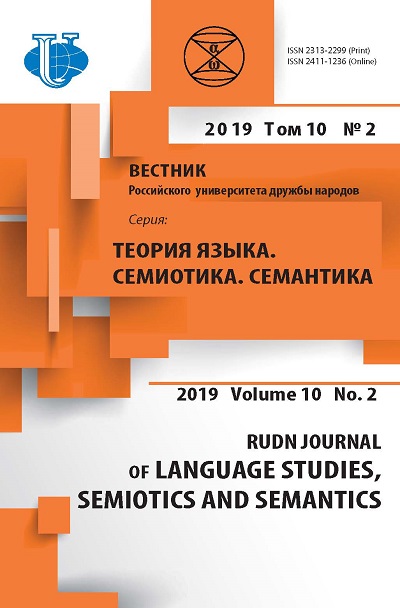IMAGE OF A WOMAN IN RUSSIAN, FRENCH, SPANISH AND MALAGASIAN LINGUO5CULTURES ON THE MATERIAL OF PAREMIA
- Authors: Novospasskaya N.V.1, Raadraniriana A.M.1, Lazareva O.V.1
-
Affiliations:
- Peoples’ Friendship University of Russia (RUDN University)
- Issue: Vol 10, No 2 (2019)
- Pages: 301-322
- Section: PHRASE RESOURCES
- URL: https://journals.rudn.ru/semiotics-semantics/article/view/21751
- DOI: https://doi.org/10.22363/2313-2299-2019-10-2-301-322
- ID: 21751
Cite item
Full Text
Abstract
The article offers an analysis of the paremias of Russian, French, Malagasy and Spanish, devoted to women. The research material was the paremiological units of these languages, obtained by continuous sampling from collections of paremias, works of art and bilingual dictionaries, the selection criterion is the presence of a woman’s lexical unit (French femme , Spanish mujer , Malagasy Vehivavy ) or a description of appearance, significance, behavior function as mother, wife, housewife, etc. in paremias in considered linguocultures. The purpose of the study is to reveal the universal and cultural-specific features of the concept of a woman in the considered corps of the Russian, French Malagasy and Spanish paremies. The tasks of the work also include consideration of the peculiarities of the paremiological and lexical units used in this fragment of the linguistic picture, as well as to describe the general and non-coinciding aspects of the origin and functioning of the antiparemia and the use of gradualness in the paremies. The selection and analysis of paremiological units showed that in the languages in question one can find paremic units characterizing a woman as ideal, intelligent, strong, etc. person, and also the importance of a woman as a housewife and her superiority over a man. A significant part of the analyzed linguistic material is made up of paradoxes in which a woman is compared with a female animal, a plant or object with which a certain quality of a woman is associated, and also a woman is presented as a stupid, talkative, unreliable, lazy, capricious person or unreasonable wife. The originality of the research is that the first time the analysis of the comparative consideration of the paremias about the woman on the material of the Russian, French, Malagasy and Spanish languages and the lexical and paremiological material of the Malagasy language introduced into the scientific circulation is made.
About the authors
Natalia V. Novospasskaya
Peoples’ Friendship University of Russia (RUDN University)
Author for correspondence.
Email: novospasskaya-nv@rudn.ru
PhD in Philology, Associate Professor at the General and Russian Linguistics Department, Philological Faculty, RUDN University
6, Miklukho-Maklaya str., Moscow, Russia, 117198Antsa Miangola Malala Raadraniriana
Peoples’ Friendship University of Russia (RUDN University)
Email: 1042165169@rudn.ru
post-graduate student at the General and Russian Linguistics Department, Philological Faculty RUDN University
6, Miklukho-Maklaya str., Moscow, Russia, 117198Olesya V. Lazareva
Peoples’ Friendship University of Russia (RUDN University)
Email: lazareva-ov@rudn.ru
PhD in Philology, Associate Professor at the General and Russian Linguistics Department, Philological Faculty, RUDN University
6, Miklukho-Maklaya str., Moscow, Russia, 117198References
- Dundes, A. (1975). On the structure of the Proverb. In Proverbium, 25, 32—53.
- Dubrovskaya, O.G. (2000).To the problem of the reflection of national identity in the proverbial-speaking fund of Russian and English. Tyumen: Tyum. State University. pp. 27—34. (In Russ.).
- Anikin, V.P. (2004). Russian oral folk art. Moscow: Higher School. (In Russ.).
- Mastepanov, S.D. (1999). About the proverbs and sayings of the peoples of the North Caucasus. Moscow: Granitsa. (In Russ.).
- Mokienko, V.M. & Nikitina, T.G. (2011). Popular wisdom. Moscow: Olma Media Group. (In Russ.).
- Permyakov, G.L. (1988). Basics of the structure of paremiology. Moscow: Nauka. (In Russ.).
- Savenkova, L.B. (2002). Russian paremiology: semantic and linguocultural aspects. Rostov N/D: RSU. (In Russ.).
- Seliverstova, E.I. (2009). The space of the Russian proverb: constancy and variability. SPb.: LLC, MIRS. (In Russ.).
- Sidorkova, G.D. (1999). The pragmatics of paremia: proverbs and sayings as speech action: monograph. Krasnodar: KSU. (In Russ.).
- Telia, V.N. (1996). Russian phraseology. Semantic pragmatic and linguistic-cultural aspects. Moscow: Shkola «Yazyki russkoj kul'tury». (In Russ.).
- Telia, V.N. (2008). Linguoculturology — the key to a new reality of the phenomenon of reproducibility of several word formations. In Telia V.N., Doroshenko A.V. Language. Culture Communication Collection of scientific papers in honor of the anniversary of S.G. Terminasovoy. Moscow: Gnosis. (In Russ.).
- Mieder, W. (1997). The Provers of Provers: From Traditional Wisdom to Proverbial stereotypes. Madison, Wis.: University of Wisconsin Press. (In Russ.).
- Taylor, A. (1962). The Proverb and the Index to the Proverb. Copenhagen: Peter Lang.
- Zouogbo, J.P. (2009). Le proverbe entre langues et étude de linguistique confrontative allemand / français / bête. Copenhagen: Peter Long.
- Rodegem, F.-M. & Brussel, P. van. (1989). Proverbes et pseudoproverbes. La logique des parémies. Strasbourg.
- Brandt, G.A. (1998). The nature of women as a problem: the concept of feminism. Social sciences and modernity, 2, 167—189. (In Russ.).
- Kirilina, A.V. & Tomsk, M.V. (2005). Linguistic Gender Studies, Domestic Notes. URL: http://www.strana-oz.ru/2005/2/lingvisticheskie-gendernye-issledovaniya (accessed: 15.04.2019). (In Russ.).
- Bryuzgina, N.K. (2007). French-Russian dictionary of proverbs and sayings. Moscow: MediaPress LLC. (In Russ.).
- Dal’, V.I. (1957). Proverbs of the Russian language. Moscow: Hudozhestvennaya literatura. (In Russ.).
- Snegirev, I.M. (1996). Dictionary of Russian proverbs and sayings. Russians in their proverbs. Nizhny Novgorod: “Russkij kupec”. (In Russ.).
- Houlder, J.A. (1990). Ohabolana, ou proverbes malgaches. Tananarive: Imprimerie Luthérienne.
- De Linci, L.R. (1842). Le livre des proverbes français. Paris: Chez Paulin.
- Khrolenko, A.T. (2006). Basics of linguoculture. Moscow: Flint: Science. (In Russ.).
- Karaulov, Yu.N. (2010). Russian language and language personality. Moscow: Nauka. (In Russ.).
- Walter, H. & Mokienko, V.M. (2005). Anti-paremias of the Russian people. SPb.: Neva. (In Russ.).
- Antonova, O.N. (2011). Syntactic transforms of paremia (on the material of English-speaking mass media). Belgorod State University Scientific Bulletin Series “Humanities”, 12 (107), 68—72. (In Russ.).
- Dumistrachel, S. (2006). Discursul repetat in textul jurnalistic. Roma: Maison d’Edition de l’Université «Alexandrue Ioan Cuza».
- Shapira, C. (2000). Proverbe, proverbialisation et déproverbialisation. Languages, 34 (139), 81—97.
Supplementary files












